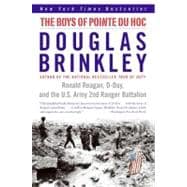
Note: Supplemental materials are not guaranteed with Rental or Used book purchases.
Purchase Benefits
What is included with this book?
| Introduction: Setting the Stage | p. 1 |
| Darby's Rangers | p. 15 |
| Rudder's Rangers | p. 35 |
| Climbing the Cliffs, Destroying the Guns | p. 63 |
| Reagan's Hollywood War | p. 99 |
| Peggy Noonan Prepares for Pointe du Hoc | p. 118 |
| Reagan's Normandy Day | p. 152 |
| After the Speeches | p. 194 |
| Epilogue | p. 213 |
| Appendix | p. 225 |
| Notes and Sources | p. 237 |
| Acknowledgments | p. 261 |
| Index | p. 265 |
| Table of Contents provided by Ingram. All Rights Reserved. |
The New copy of this book will include any supplemental materials advertised. Please check the title of the book to determine if it should include any access cards, study guides, lab manuals, CDs, etc.
The Used, Rental and eBook copies of this book are not guaranteed to include any supplemental materials. Typically, only the book itself is included. This is true even if the title states it includes any access cards, study guides, lab manuals, CDs, etc.
As a movie actor, history buff, and unabashed nationalist,President Ronald Reagan, while he prepared for thefortieth anniversary of D-Day, was keenly aware of thesheer power the word "ranger" conjured in the Americanimagination, even if his facts about their early combat anticswere -- as historian Garry Wills claims -- often of the Disneylandtriumphalist variety. Ever since Jamestown was establishedby English settlers in 1607, "rainger" or "ranger" hadbecome part of the New World vocabulary. Feeling vulnerableto attack by Native Americans, early colonists dispatchedarmed scouts to roam the wilderness and, if necessary, exterminatepotential enemies before any Indians could wreak havoc on their Christian communities. The daily reports ofthese scouts often said something like "ranged twenty milesyesterday" or "too rainy to range far," so it didn't take longfor the term "ranger" to stick. They were, in effect, wildernesspatrolmen. They realized early on that European-stylewarfare was unsuitable to America's roiled terrain. Rangers,adjusting to topography, adopted the stealth tactics and nomadicways of the various Indian tribes who freely roamedthe eastern seaboard, and they aroused the hostility of theNative Americans inhabiting it. Such combat was almost theantithesis of European warfare, which at the time consistedof much maneuvering and very little fighting. "In the lastdecades of the seventeenth century rangers acting as quasimilitaryunits first appeared in Massachusetts and Virginia,"historian Jerome Haggerty noted. "At that time combat inNorth America was influenced by the wilderness."
As soon as the French and Indian War (1756–1763) brokeout, a Natty Bumppo-like New Hampshire backwoodsmannamed Robert Rogers, livid that Native American warriorsconstantly ambushed local forts and homesteads in hit-andrunraids, sought revenge. He signed up with the BritishArmy to be a scout. Before long he received a commission ascaptain and organized a "ranger" team of a few dozen mentrained for hand-to-hand combat against both the Frenchand Indians. Officially they were the Ranger Company of theNew Hampshire Provincial Regiment; a year later they hadbecome His Majesty's Independent Company of AmericanRangers. Clad in distinctive green outfits, they eventually becameknown as Rogers' Rangers and soon attacked Frenchfortifications along Lake Champlain and Lake George. Accordingly, Rogers was dubbed Wabi Madaondo, or whitedevil, by the Indians who crossed his path. He, in turn, saidthat Native Americans had "revengeful" dispositions in his1765 book, A Concise Account of North America. "Throughoutthe French and Indian War, Rogers, and his Rangers, continuedto wage unconventional warfare throughout the upperNew York, lower Canadian, and even French West Indies regions,"historian J. D. Lock wrote. "Following the war, therewere periodical ‘revivals' of Rogers' Rangers in support ofBritish Operations until 1763 when they were ‘paid off' forthe first time."
The very notion of these rangers -- often with smeared warpaint on their faces and waving sharp knives -- caused unmitigatedfear among the various Native American tribes (particularlythe Abenaki St. Francis Indians) warring against theBritish empire. Teaching his mobile recruits how to live off theland, Rogers often took advantage of subzero winter weatherto catch his slumbering enemies off guard. By using speciallymade snowshoes, Rogers' Rangers could cross frozen riversand lakes with bold ease, startling their unexpecting adversaries.Unusual for military men of the colonial era, thesehardened rangers sought to unnerve their opponents by engagingin everything from blood-curdling yells to midnightattacks. Lightning-fast raids were their specialty. Decimatingthe enemy was all that mattered. Almost intuitively, Rogers'Rangers understood what, according to historian Robert W.Black, would become the modern-day mantra for the U.S.Army Rangers: "It is all in the heart and the mind."
During the American Revolution, Rogers volunteeredto serve George Washington; the general refused his help, fearful he was a loyalist spy. Snubbed, Rogers abandonedthe call for independence and instead organized a battalionof pro-British loyalist commandos known best as the Queen'sRangers. If Washington didn't trust him he would remainloyal to King George III. Back in Virginia, however, a newvolunteer outfit, clad in coonskin caps and equipped withlong rifles and hunting knives, took the fight to the Redcoats.Led by Captain Daniel Morgan, this ranger battaliondid whatever chore was needed, from toggling across the swiftcurrents of New York rivers to doing surveillance scoutingin the pristine Virginia countryside. A great motivator ofmen, Morgan used a recruitment test that became legendaryamong Washington's Continental Army. He printed up numerousbroadside illustrations of King George's robust head.To join his rangers you had to be able to shoot the Britishmonarch in the face from 100 yards away, usually on thefirst try. Because of this hateful recruitment practice, Morganwas deemed a "war criminal" in London.
The Boys of Pointe du Hoc
Excerpted from The Boys of Pointe du Hoc: Ronald Reagan, D-Day, and the U. S. Army 2nd Ranger Battalion by Douglas G. Brinkley, Douglas Brinkley
All rights reserved by the original copyright owners. Excerpts are provided for display purposes only and may not be reproduced, reprinted or distributed without the written permission of the publisher.